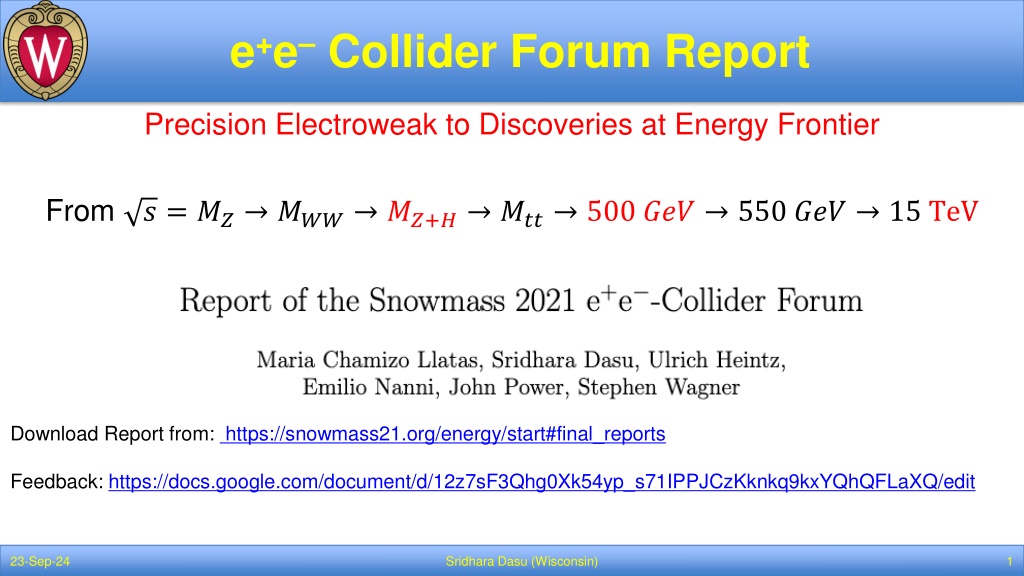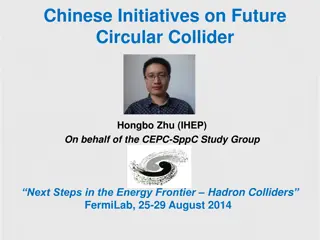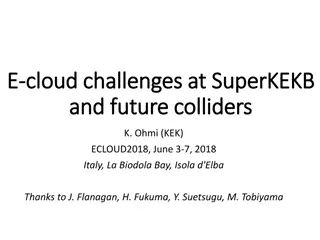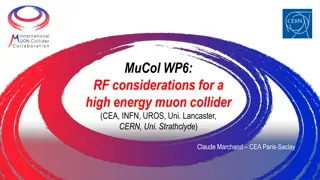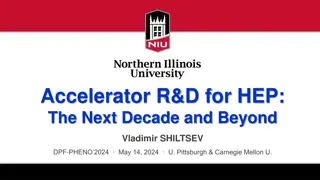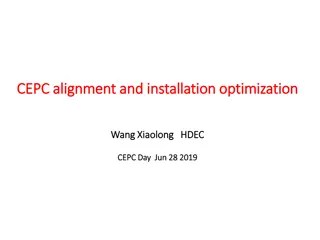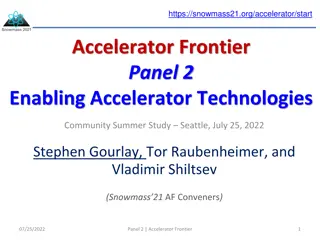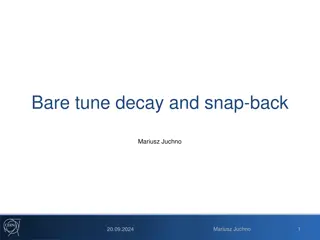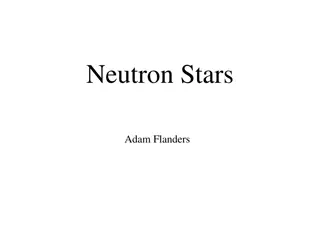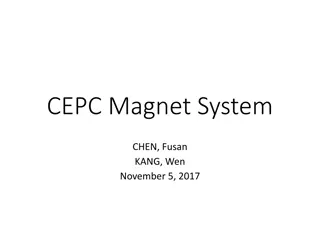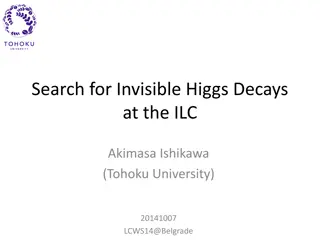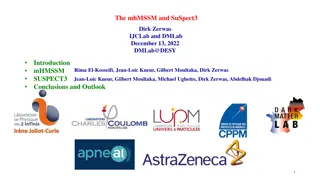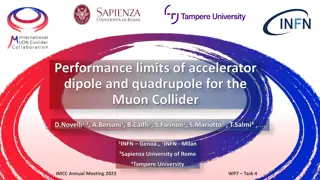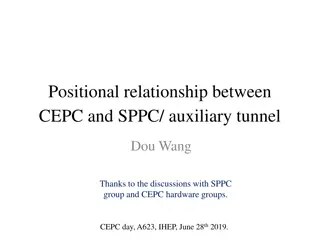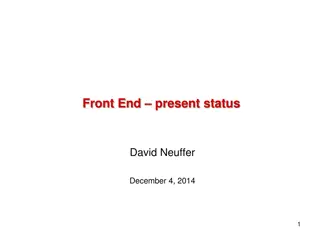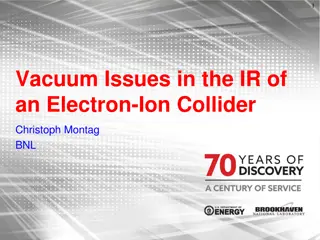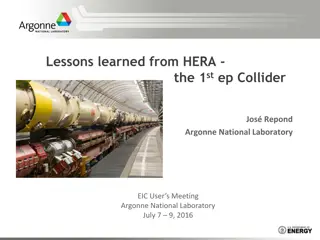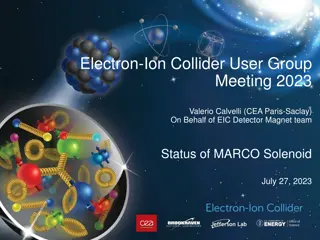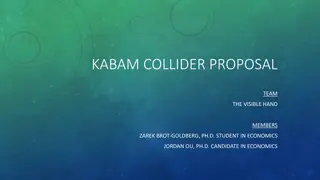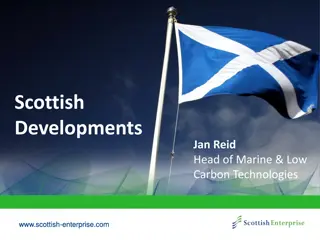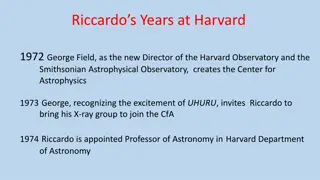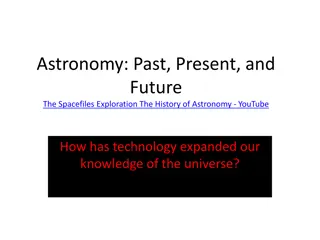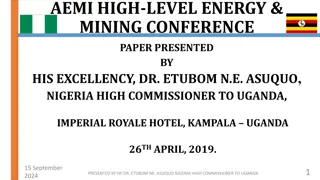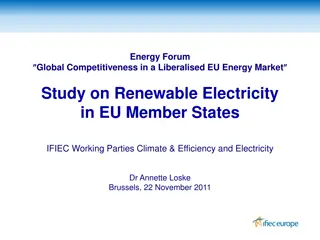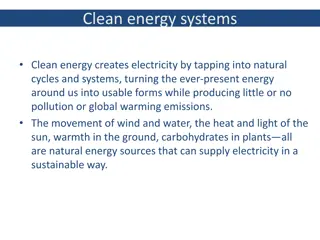Advancements in High-Energy Collider Technology and Discoveries
Explore the latest developments in collider technology, focusing on precision electroweak measurements and discoveries at the energy frontier. Reports highlight advancements in circular colliders, linear colliders, and the status of machine designs and risks. Key topics include luminosity, energy reach, and beam delivery advances. Visit the provided links for detailed information and feedback.
Download Presentation

Please find below an Image/Link to download the presentation.
The content on the website is provided AS IS for your information and personal use only. It may not be sold, licensed, or shared on other websites without obtaining consent from the author. Download presentation by click this link. If you encounter any issues during the download, it is possible that the publisher has removed the file from their server.
E N D
Presentation Transcript
e+eCollider Forum Report Precision Electroweak to Discoveries at Energy Frontier From ? = ?? ??? ??+? ??? 500 ??? 550 ??? 15 TeV Download Report from: https://snowmass21.org/energy/start#final_reports Feedback: https://docs.google.com/document/d/12z7sF3Qhg0Xk54yp_s71IPPJCzKknkq9kxYQhQFLaXQ/edit 23-Sep-24 Sridhara Dasu (Wisconsin) 1
e+e Collider Forum Report From ? = ?? ??? ??+? ??? 500 ??? 550 ??? 15 TeV Shovel Ready Higgs Factory Advanced Concepts O(10) TeV 23-Sep-24 Sridhara Dasu (Wisconsin) 2
ITF Evaluated Collider Types Circular Colliders From ? = ?? ??? ??+? ??? Tera-Z, millions of H very high luminosity Upgrade to pp-machine for high energy Linear Colliders Polarization, Energy Reach From ? = ?? ??? ??+? 550 GeV Upgraded / Expanded facilities: ? 3 TeV Advanced technologies: ? 15 TeV Beam Delivery Advances for high luminosity 23-Sep-24 Sridhara Dasu (Wisconsin) 3
ITF: Luminosity vs ? Landscape 23-Sep-24 Sridhara Dasu (Wisconsin) 4
ITF: Machine Design Status and Risk Design Status I. TDR Complete II. CDR Complete III. Substantial Docs IV. Limited Docs Risk I. Low Risk II. Medium Low Risk III. Medium High Risk IV. High Risk 23-Sep-24 Sridhara Dasu (Wisconsin) 5
ITF: Machine R&D & Physics Timelines Shovel Ready Higgs Factory ASAP O(10) TeV e+e R&D Need 23-Sep-24 Sridhara Dasu (Wisconsin) 6
ITF: Core Accelerator Parameters (Cost Drivers) Active LINAC Length Beam Delivery System ~ 3km Active LINAC Length BDS Larger 23-Sep-24 Sridhara Dasu (Wisconsin) 7
Luminosity / Power vs Energy from ITF Points computed from proponent submitted parameters table Uncertainty band is ITF judgement based on many considerations: technical design status, risk assessment, 23-Sep-24 Sridhara Dasu (Wisconsin) 8
FWIW ITF Estimated Costs Difficult to estimate accurately Depends on methods used Individual proponents have their own estimates ITF did the best to treat all machines on equal footing with ~uniform method 23-Sep-24 Sridhara Dasu (Wisconsin) 9
Physics Timeline vis--vis Integrated Luminosity Caveat run plans are adjustable; start of physics times are different Technically feasible times: ILC < 12y, FCC-ee, CLIC, CEPC, C3 : 13-18y ILC shovel ready awaiting funding decision, potential for earliest start FCC-ee, CLIC post HL-LHC Circular colliders have shorter runs, higher luminosity Linear collider runs have access to polarization and higher energy Possibly earlier project start (Shovel ready ILC) Both provide good precision on Higgs Couplings & EWK 23-Sep-24 Sridhara Dasu (Wisconsin) 10
Higgs Couplings 23-Sep-24 Sridhara Dasu (Wisconsin) 11
Top-Yukawa and Higgs Self-Coupling Advantages of Energy Reach Double Higgs production Precision of HHH ECM (TeV) HL-LHC 50% ILC 0.5 20% CLIC 1.5 36% CLIC 3 9% Col 10 4% 23-Sep-24 Sridhara Dasu (Wisconsin) 12
Electroweak Observables ILC GigaZ is a big improvement over current status FCC-ee TeraZ suggests even bigger leap forward in precision 23-Sep-24 Sridhara Dasu (Wisconsin) 13
Detectors for e+e Colliders Main features Pixel tracker with lowest possible mass and possible radius Low-mass outer tracker for excellent momentum resolution to high energies A highly segmented calorimeter for particle flow A large superconducting solenoid enclosing above Muon chambers Triggerless readout Additional features Timing detectors Particle ID K p separation Highly segmented detectors with good resolution were simulated to make physics studies We do need those fancy detectors to meet those physics goals! 23-Sep-24 Sridhara Dasu (Wisconsin) 14
Detector R&D Partial Itemized List Several R&D paths need to be supported, e.g., Reduction of the material in the trackers to minimize multiple scattering Monolithic Active Pixel Sensors (MAPS) increased granularity Low-Gain Avalanche Diodes (LGAD) potential for time measurement 3D integration may reduce the material in pixelated sensors-readout assemblies and improve their performance and reliability Thin film detectors to drastically reduce the amount of material Submicron pixels with a quantum well to improve the position resolution of vertex detectors Precision of the timing of signals in the tracker and the calorimeter into the 10 ps range 4D / 5D Reconstruction, Particle ID Modern versions of Ring Imaging Cherenkov and Transition Radiation Detectors R&D to develop technologies to efficiently distribute power and cooling R&D to make the technologies scalable to enable the construction of a large detectors 23-Sep-24 Sridhara Dasu (Wisconsin) 15
Detector R&D Needs Preparation of a Technical Design for a Detector needs an R&D program That goes beyond generic R&D is needed Address the specific detector challenges for e+e colliders. Such a program needs to start now for the technology to build a full-scale e+e collider detector For the Higgs Factory research program to begin ASAP ! Synergies continue to help, even in case of non-generic R&D Past example: CALICE to CMS HGCal Short-term: LHC Phase-2 Upgrades, EIC, Mu2e Long-term: Proton-collider & muon-collider detectors 23-Sep-24 Sridhara Dasu (Wisconsin) 16
Synergies The vast majority of ~30,000 currently operating accelerators globally are electron accelerators. Electron accelerator R&D ranges from industrial applications to the cutting-edge development of ultimate storage rings and linear accelerator based XFELs. This fortunate situation allows e+e colliders to leverage these global efforts to provide a viable path to a collider reducing the R&D costs to the HEP budget. 23-Sep-24 Sridhara Dasu (Wisconsin) 17
Conclusion from Executive Summary Given the strong motivation and existence of proven technology to build an e+e Higgs Factory in the next decade, the US should participate in the construction of any facility that has firm commitment to go forward. Awaiting such commitment, the US should also pursue research and development of multiple options in this decade. This ensures that the global community will be able to begin constructing at least one such machine in the following decade Potential siting of a facility (ILC? C3? ) in the USA should also be pursued. US investments in further advancing technology will ensure the technical readiness of proposed facilities, improves the eventual physics reach of a collider and maintains the community engagement needed for the US to contribute to the construction of a collider. 23-Sep-24 Sridhara Dasu (Wisconsin) 18
The e+e Community Asks from EF & AF Reports We hope Snowmass Community Leaders & Eventually P5 support: Higgs Factories (from EF draft report) Starting 2025: Establish a targeted e+e Higgs Factory detector R&D progress for US participation in a global collider Starting 2030: Support construction of an e+e Higgs Factory After 2035: Begin and support the physics program of the Higgs Factories Ramp up funding support for detector R&D for EF multi-TeV Colliders Wake Field Accelerators (Presently, GARD funded) (from AF draft report) Advanced wake field accelerator concepts should strive toward feasibility studies and integrated design reports for an O(10 TeV c.m.e.) collider and experimentally demonstrate collider-quality emittances, efficiencies and energy spreads, staging, final focusing schemes and positron acceleration. Targeting 10 ab 1 or above for 10-TeV e+e Reduction of power consumption is one of the main challenges of future colliders. ERLs 23-Sep-24 Sridhara Dasu (Wisconsin) 19
